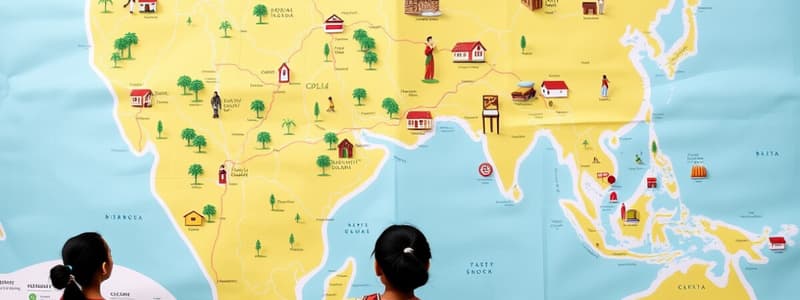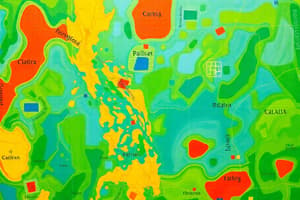Podcast
Questions and Answers
What is the primary purpose of cultural mapping?
What is the primary purpose of cultural mapping?
- To standardize cultural practices across different communities
- To create a universal definition of cultural identity
- To document and celebrate diverse cultural identities (correct)
- To eliminate cultural differences in urban planning
Participatory mapping in cultural mapping primarily involves which of the following?
Participatory mapping in cultural mapping primarily involves which of the following?
- Engaging community members to contribute (correct)
- Using only historical documents and archives
- Excluding community members from the process
- Mapping only physical locations of cultural assets
Which factor does NOT influence cultural identity?
Which factor does NOT influence cultural identity?
- Language
- Fashion trends (correct)
- Traditions
- Heritage
What are cultural narratives primarily associated with?
What are cultural narratives primarily associated with?
Which application of cultural mapping is NOT mentioned in the content?
Which application of cultural mapping is NOT mentioned in the content?
Which of the following is a key component of cultural mapping?
Which of the following is a key component of cultural mapping?
Which methodology in cultural mapping aims to visually document cultural elements?
Which methodology in cultural mapping aims to visually document cultural elements?
What role does language play in cultural identity?
What role does language play in cultural identity?
What does cultural anthropology primarily focus on?
What does cultural anthropology primarily focus on?
What does cultural relativism emphasize?
What does cultural relativism emphasize?
Which research method involves immersing oneself in a culture?
Which research method involves immersing oneself in a culture?
Which factor is NOT typically linked to transformations in cultural practices?
Which factor is NOT typically linked to transformations in cultural practices?
What impact can migration have on cultures?
What impact can migration have on cultures?
What is an example of a revitalization movement?
What is an example of a revitalization movement?
How does technology influence cultural practices?
How does technology influence cultural practices?
What is NOT a potential impact of cultural transformation?
What is NOT a potential impact of cultural transformation?
Flashcards
Cultural Mapping
Cultural Mapping
A method to visualize and understand cultural assets, practices, and identities in a community.
Cultural Assets
Cultural Assets
Local traditions, languages, art forms, festivals, and historical sites within a community.
Cultural Practices
Cultural Practices
Day-to-day activities, rituals, and celebrations that shape a community's identity.
Cultural Narratives
Cultural Narratives
Stories and histories that shape the understanding of a community’s identity.
Signup and view all the flashcards
Cultural Identity
Cultural Identity
The sense of belonging to a culture, influenced by shared ethnicity, language, traditions, and history.
Signup and view all the flashcards
Heritage
Heritage
Ancestral background and historical context that influence cultural identity.
Signup and view all the flashcards
Language
Language
A primary means of communication that conveys cultural nuances and identity.
Signup and view all the flashcards
Traditions
Traditions
Customs and practices passed down through generations, shaping cultural identity.
Signup and view all the flashcards
Community
Community
Shared experiences and collective memory among individuals, enhancing cultural identity.
Signup and view all the flashcards
Participatory Mapping
Participatory Mapping
Engaging community members to contribute to the mapping process, ensuring diverse voices are represented.
Signup and view all the flashcards
Visual Documentation
Visual Documentation
Using photos, drawings, and digital tools to capture cultural elements and identities visually.
Signup and view all the flashcards
Interviews and Workshops
Interviews and Workshops
Gathering personal stories and insights from community members to enrich cultural mapping.
Signup and view all the flashcards
Cultural Anthropology
Cultural Anthropology
Focuses on human cultural variation, examining social norms, values, and practices.
Signup and view all the flashcards
Ethnography
Ethnography
In-depth research involving direct observation and participation in cultures.
Signup and view all the flashcards
Cultural Relativism
Cultural Relativism
Understanding cultures based on their own context and standards, minimizing bias.
Signup and view all the flashcards
Transformations in Cultural Practices
Transformations in Cultural Practices
The evolution of cultural expressions and social practices due to various influences.
Signup and view all the flashcardsStudy Notes
Cultural Mapping: Cultural Identity
-
Definition: Cultural mapping is a process used to visualize and understand the cultural assets, practices, and identities within a specific community or region.
-
Purpose:
- To document and celebrate the diverse cultural identities present in a community.
- To identify cultural resources and heritage.
- To facilitate community engagement and participatory planning.
-
Key Components:
- Cultural Assets: Includes local traditions, languages, art forms, festivals, and historical sites.
- Cultural Practices: Day-to-day activities, rituals, and celebrations that define a community's identity.
- Cultural Narratives: Stories and histories that shape the understanding of a community’s identity.
-
Cultural Identity:
- Concept: Refers to the sense of belonging to a particular culture, influenced by factors such as ethnicity, language, traditions, and shared history.
- Factors Influencing Cultural Identity:
- Heritage: Ancestral background and historical context.
- Language: Primary means of communication that conveys cultural nuances.
- Traditions: Customs and practices passed down through generations.
- Community: Shared experiences and collective memory among individuals.
-
Methodologies:
- Participatory Mapping: Engaging community members to contribute to the mapping process, ensuring diverse voices are represented.
- Visual Documentation: Using photographs, drawings, and digital tools to capture cultural elements and identities visually.
- Interviews and Workshops: Gathering personal stories and insights from community members to enrich the mapping process.
-
Applications:
- Urban Planning: Informing development projects with cultural considerations.
- Cultural Policy: Supporting policies that sustain and promote cultural diversity.
- Education: Enhancing awareness and appreciation of local cultures in schools.
-
Challenges:
- Representation: Ensuring all cultural identities within a community are adequately represented.
- Dynamic Nature: Cultural identities evolve over time, requiring continuous updates to mapping efforts.
- Resource Allocation: Securing funding and support for cultural initiatives.
-
Outcomes:
- Enhanced community cohesion and pride.
- Improved cultural awareness and sensitivity among residents and policymakers.
- Preservation of cultural heritage for future generations.
Definition and Purpose of Cultural Mapping
- Cultural mapping visualizes and comprehends cultural assets, practices, and identities within a community or region.
- Aims to document and celebrate diverse cultural identities, identify cultural resources, and facilitate community engagement and participatory planning.
Key Components of Cultural Mapping
- Cultural Assets: Encompasses local traditions, languages, art forms, festivals, and historical sites.
- Cultural Practices: Day-to-day activities, rituals, and celebrations that shape a community's identity.
- Cultural Narratives: Stories and histories that contribute to understanding a community’s identity.
Understanding Cultural Identity
- Concept: Represents the sense of belonging to a culture influenced by ethnicity, language, traditions, and shared history.
- Influential Factors:
- Heritage: Ancestral background shapes cultural context.
- Language: Acts as a primary communication means, conveying cultural nuances.
- Traditions: Customs passed through generations play a vital role.
- Community: Shared experiences and collective memory enhance identity.
Methodologies in Cultural Mapping
- Participatory Mapping: Involves engaging community members to contribute, ensuring diverse representation.
- Visual Documentation: Captures cultural elements through photographs, drawings, and digital tools.
- Interviews and Workshops: Collects personal stories and insights to enrich cultural mapping.
Applications of Cultural Mapping
- Urban Planning: Informs development projects with cultural considerations.
- Cultural Policy: Supports policies that maintain and promote cultural diversity.
- Education: Enhances cultural awareness and appreciation within school curricula.
Challenges in Cultural Mapping
- Representation: There is a need to ensure all cultural identities in the community are adequately represented.
- Dynamic Nature: Acknowledges the evolving aspect of cultural identities, requiring ongoing updates.
- Resource Allocation: Necessitates securing funding and support for cultural initiatives.
Outcomes of Cultural Mapping
- Promotes enhanced community cohesion and pride among members.
- Improves cultural awareness and sensitivity among residents and policymakers.
- Aids in preserving cultural heritage for future generations.
Cultural Anthropology
- Focuses on cultural variation among humans, examining social norms, values, and practices.
- Key Concepts:
- Ethnography: In-depth research methodology involving direct observation and active participation in cultures.
- Cultural Relativism: The approach of understanding cultures based on their own context and standards, minimizing bias.
- Symbolism: Examines how symbols play a crucial role in cultural expression and communication.
- Kinship: Investigates family structures, relationships, and their significance in different cultures.
- Language: Analyzes the relationship between language and cultural identity, highlighting how language shapes perception.
- Research Methods:
- Participant Observation: Engaging in cultural practices to gain insight and firsthand knowledge.
- Interviews: Conducting discussions to gather personal stories and cultural insights from individuals.
- Surveys: Utilizing structured questionnaires to collect data for trend analysis within cultures.
Transformations In Cultural Practices
- Involves the evolution of cultural expressions and social practices over time due to various influences.
- Key Factors Influencing Transformation:
- Globalization: Facilitates the exchange of ideas and cultural practices worldwide, creating interconnected cultural landscapes.
- Technology: Alters cultural dissemination through digital media, influencing how cultures are shared and experienced.
- Migration: Contributes to cultural blending, resulting in hybrid cultures that combine elements from multiple traditions.
- Social Movements: Grassroots activism plays a critical role in reshaping and reinterpreting cultural norms.
- Economic Change: Influences traditional lifestyles, altering practices in response to shifts in economic conditions.
- Examples of Transformation:
- Cultural Adaptation: Local cultures adjust to global trends while striving to maintain their unique identities and heritage.
- Revitalization Movements: Initiatives aimed at preserving endangered cultural practices and reviving traditional customs.
- Hybrid Cultures: New cultural forms emerge from the intersection of different traditions, creating innovative practices.
- Impacts of Transformation:
- Identity: The changing landscape of cultural practices influences both personal and collective identities.
- Conflict: Cultural differences and changes can lead to tensions, with the potential for clashes between traditions.
- Preservation: There is a growing effort to document and sustain traditional practices in the face of increasing modernization.
Studying That Suits You
Use AI to generate personalized quizzes and flashcards to suit your learning preferences.




